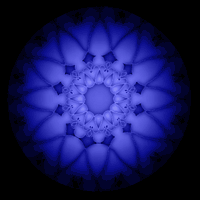... and they'll tell two of their friends, and...
Infinite: Bigger than the biggest thing ever and then some. Much bigger than that, in fact, really amazingly immense, a totally stunning size, real "wow, that's big" time. Infinity is so big that by comparison, bigness itself looks really titchy. Gigantic multiplied by colossal multiplied by staggeringly huge is the sort of concept we're trying to get across here.
—Douglas Adams, "The Restaurant at the End of the Universe"
Raju Varghese has a thing about exponential growth and division. He's written up a few examples to try and get the point across about just how quickly a process as simple as doubling a number can shoot up towards infinity. I'd heard the one about putting grains of rice (or coins) on the squares of a checkerboard, but I did not know that if it were possible to fold a piece of paper in half 100 times the resultant stack would be approximately the same size as the radius of the known universe.
He gets the final number wrong, but when you're talking about light-years I think it's safe to just be in the ballpark. Or even in the galaxy. He assumes a paper thickness of 0.1mm, so
100
2 * 0.1mm = 126765060022822940149670320537.6 mm
= ~126765060022822940149670320 m
= ~422842725492523698 light-seconds
= ~7047378758208728 light-minutes
= ~117456312636812 light-hours
= ~4894013026533 light-days
= ~13408254867 light-years
That's ~13.4 billion light-years... it is currently believed that the universe is 13.7 billion years old, and therefore the distance from the 'center' to the 'edge' (whatever the hell those mean in this context) is 13.7 billion light-years.
An interesting side note is that this is an even more abstract mental exercise than it appears to be, because until a few years ago it was believed that it was physically impossible to fold a sheet of paper in half more than 7 times. Try it with a normal sheet of paper... after the seventh fold, the stack of paper is taller than it is wide and there's no way to fold it again... in cross-section the stack is 128 layers thick. Newspaper: same deal. Tissue paper: same deal. Try it.
In 2001 Britney Gallivan, a high-school student, figured out the mathematical formulae that describe the limits of this folding process, and in doing so she discovered a way to fold a sheet (or in this case a 4000-foot roll) of paper in half 12 times. People have been talking about this for a couple of hundred years, and a high-school student figured it out for extra-credit in her math class. I realize this isn't a world-changing discovery, but I still hope someone gave her a scholarship or something.

3 Comments:
pomonahistorical.org/12times.htm
It's an ongoing problem with a blog... the net is a moving target.
Wild that the work was on Numb3rs.
Thanks for the update.
return to front page